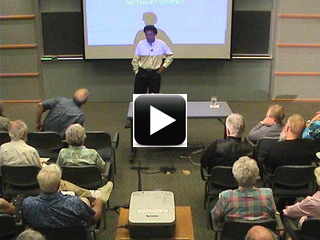Transitions from order to chaos have been widely studied by physicists
in the context of fluid turbulence and other dynamical systems.
Recently, physicists have teamed up with biologists and clinicians to
help tame cardiac fibrillation, a form of wave turbulence that stops the
heart from pumping blood and is the leading cause of sudden death among
industrialized nations. Medical doctors routinely defibrillate patients
on the show ER and in real life. Some high risk patients can carry
implantable defibrillators. However, reducing mortality in the wider
population of patients who die suddenly and unpredictably from
ventricular fibrillation has remained a major challenge. At the heart of
this challenge is a quest for a fundamental understanding of electrical
waves that propagate contraction through the main chambers of the heart.
These highly nonlinear waves behave quite differently from the linear
waves that propagate sound or light. Plane waves annihilate when they
collide and can break up into rapidly rotating spiral-shaped waves that
are widely believed to cause fibrillation. Furthermore, wave propagation
is governed by an electrical circuitry of bewieldering complexity at
molecular, cellular, and tissue scales. In this lecture, I will review
the rich scientific history that has lead to modern conceptualizations
of fibrillation. I will also discuss recent insights into wave dynamics
from a physics perspective that offers new prospects to tame cardiac
fibrillation and goes beyond the limitations of current therapies.

Alain Karma is a Professor of Physics and College of Arts and Sciences
Distinguished Professor at Northeastern University, as well as Interim
Director of the Center for Interdisciplinary Research on Complex
Systems. Prior to joining Northeastern, he received his PhD in Physics
from the University of California at Santa Barbara in 1985 and
subsequently held a 3-year postdoctoral appointment at the California
Institute of Technology as a Weingart Research Fellow in Theoretical
Physics. His research focuses on theoretical understanding of the
emergence of nonequilibrium patterns with applications to a wide range
of problems in materials science and biology. He has authored widely
cited groundbreaking papers that introduced a paradigm shift away from
old beliefs about what causes electrical wave turbulence in the heart.
Movie of introduction by David Gross.
 Other video options
Other video options
To begin viewing slides, click on the first slide below. (Or, view as pdf.)
![[01]](tn/01.jpg)
![[02]](tn/02.jpg)
![[03]](tn/03.jpg)
![[04]](tn/04.jpg)
![[05]](tn/05.jpg)
![[06]](tn/06.jpg)
![[07]](tn/07.jpg)
![[08]](tn/08.jpg)
![[09]](tn/09.jpg)
![[10]](tn/10.jpg)
![[11]](tn/11.jpg)
![[12]](tn/12.jpg)
![[13]](tn/13.jpg)
![[14]](tn/14.jpg)
![[15]](tn/15.jpg)
![[16]](tn/16.jpg)
![[17]](tn/17.jpg)
![[18]](tn/18.jpg)
![[19]](tn/19.jpg)
![[20]](tn/20.jpg)
![[21]](tn/21.jpg)
![[22]](tn/22.jpg)
![[23]](tn/23.jpg)
![[24]](tn/24.jpg)
![[25]](tn/25.jpg)
![[26]](tn/26.jpg)
![[27]](tn/27.jpg)
![[28]](tn/28.jpg)
![[29]](tn/29.jpg)
![[30]](tn/30.jpg)
![[31]](tn/31.jpg)
![[32]](tn/32.jpg)
![[33]](tn/33.jpg)
![[34]](tn/34.jpg)
![[35]](tn/35.jpg)
![[36]](tn/36.jpg)
![[37]](tn/37.jpg)
![[38]](tn/38.jpg)
![[39]](tn/39.jpg)
![[40]](tn/40.jpg)
![[41]](tn/41.jpg)
![[42]](tn/42.jpg)
![[43]](tn/43.jpg)
![[44]](tn/44.jpg)
![[45]](tn/45.jpg)
![[46]](tn/46.jpg)
![[47]](tn/47.jpg)
![[48]](tn/48.jpg)
![[49]](tn/49.jpg)
![[50]](tn/50.jpg)
![[51]](tn/51.jpg)
![[52]](tn/52.jpg)
![[53]](tn/53.jpg)
![[54]](tn/54.jpg)
![[55]](tn/55.jpg)
![[56]](tn/56.jpg)
![[57]](tn/57.jpg)
![[58]](tn/58.jpg)
![[59]](tn/59.jpg)
![[60]](tn/60.jpg)
![[61]](tn/61.jpg)
![[62]](tn/62.jpg)
![[63]](tn/63.jpg)
![[64]](tn/64.jpg)
![[65]](tn/65.jpg)
![[66]](tn/66.jpg)
![[67]](tn/67.jpg)
![[68]](tn/68.jpg)